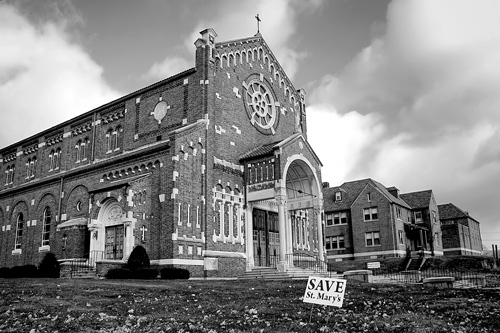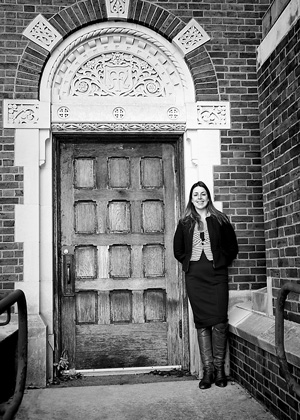News December 2014-January 2015
Keeping a city’s past intact
In Pittsfield, campaign to save church leads to wider preservation effort
 By JOHN TOWNES
By JOHN TOWNES
Contributing writer
PITTSFIELD, Mass.
The former St. Mary the Morning Star Church in Pittsfield has helped to spawn a new preservation drive in the city after a developer proposed this fall to raze it to make way for a Dunkin’ Donuts shop.
The recent threatened demolition of a landmark former Catholic church has rekindled long-running concerns about whether Pittsfield as a community needs to do more to preserve the older buildings that collectively give the city its streetscapes and identity.
After the news broke in September that a developer was planning to tear down the former St. Mary the Morning Star Church on Tyler Street and replace it with a Dunkin’ Donuts, a public outcry prompted the developer to back off from those plans.
The fate of St. Mary’s is still unresolved. The developer has made an informal offer to preserve the church building itself -- if an appropriate plan for its use can be worked out in conjunction with the company’s plans for other sections of the property.
Now local preservationists and city officials are searching for a viable proposal for reusing the structure, which has been vacant since 2008.
At the same time, the episode has sparked a larger drive for a more proactive approach for protecting other older buildings in the city – and for guiding their redevelopment, if necessary, before they get to the point of being threatened with demolition.
“Larger cities have preservation societies,” explained Darcie Sosa, one of the leaders of the campaign to save St. Mary’s. “That’s something we should have in Pittsfield and throughout Berkshire County. These buildings have served important roles in the past, and they can continue to be valuable resources. Beyond saving St. Mary’s, we hope that this effort will build momentum for the creation of that type of a regional organization.”
The efforts by Sosa and others prompted Mayor Daniel Bianchi to organize a special community summit meeting last month to discuss issues and strategies related to preserving the city’s historic buildings. The forum included city officials, local preservationists and developers and others with experience in renovating and repurposing historic structures.
“If the community wants to save these buildings, this is an issue that we all should be discussing,” Bianchi said. “There’s no doubt that situations like this will continue to happen again. For example, there are a number of other houses of worship that could be lost in the coming years.”
Some say the city’s preservation efforts should be cast broadly, covering not just buildings of designated historical significance but also some more recent structures that have become a familiar and defining part of the city’s streetscape.
The St. Mary’s building, for example, is 73 years old. That makes it two years too young to be considered a historic structure under the city’s current rules, even though its unique and ornate architecture make it a familiar local landmark.
The campaign for St. Mary’s
St. Mary’s, in the city’s northeastern Morningside neighborhood, was closed and decommissioned in 2008 and is just one of many churches in the region that have been shuttered by the Roman Catholic Diocese of Springfield in recent years. In addition to the 9,600-square-foot church building, the 2.5-acre property includes several separate buildings that were used as a parish house, school and for other purposes.
In early September, news reports revealed that Cafua Management, a company that operates nearly 300 Dunkin’ Donuts stores including four in Pittsfield, had applied for a permit to demolish the church building as part of its negotiations to buy the property from the diocese. The company confirmed that it planned to tear down the buildings at the site and replace them with a new Dunkin’ Donuts with a drive-through window.
The plans set off a wave of opposition and debate in the city. Although some people were either ambivalent or saw the redevelopment of the site as progress, many others rallied to save the church. Some were moved by sentiment, as the church had a major role in the lives of its parishioners and the larger community, but preservationists also believe the building could be redeveloped for a community-oriented or commercial purpose.
News of church’s planned demolition also touched a deeper nerve in Pittsfield, which has lost a series of landmark buildings over the years. Earlier this year, the former William Plunkett School at First and Fenn streets was torn down, despite widespread public opposition. The two-story brick-and-limestone structure, built in 1909 as the city’s first junior high school, was razed by Cafua Management to make way for another Dunkin’ Donuts shop.
An online petition, protesting the demolition of St. Mary’s and calling for its preservation, quickly garnered some 1,600 signatures at Change.org.
The proposal also sparked the formation of the independent, community-based Friends of St. Mary committee. The group has a core of about 10 people, including former parishioners, several former city councilors and others with an interest in saving the church building.
By the end of September, Cafua announced that it would prepare a new plan for the St. Mary’s site that would leave the church building intact. The company also said it would offer to donate the building to the city.
Preserving an urban fabric
Sosa, a professional writer and communications consultant, organized the online petition to save St. Mary’s and now serves as a spokeswoman for a newly formed preservation committee.
She had previously launched a similar petition drive as part of a successful campaign to prevent the CVS drugstore chain from demolishing St. Francis of Assisi, a vacant Catholic church in downtown North Adams.
She said she became involved with these projects because she believes older structures are important to retain, both to preserve local identity and quality of life and as a resource to attract businesses, residents and tourism.
“Like many people in the Berkshires, I take great pride in where we live,” Sosa explained. “St. Mary’s is a beautiful example of the type of building that gives Pittsfield its character.”
She pointed out that ongoing efforts to revitalize the Morningside neighborhood have included the successful repurposing of other older buildings such as the nearby Silk Mill, a former factory that has been converted into a mixed-income housing complex.
“The St. Mary’s building is in a position to contribute to the momentum of those initiatives,” she said.
Beyond that, she added, studies show that retaining the traditional architecture of communities is a resource for tourism and other forms of economic development.
“There are many other places people can go to just see mountains and scenery,” she said. “What attracts people and businesses to Berkshire County is the unique combination of natural beauty, culture and the traditional streetscapes and character of Pittsfield and other communities here. It’s important to maintain that balance. If we tear down these older buildings, our cities and towns will look like anyplace else, and we will lose the uniqueness that draws people here.”
Searching for a new purpose
Although Cafue has said it would donate St. Mary’s to the city, it so far has not closed on the purchase from the diocese, and the terms of its offer to the city remain unclear.
Bianchi said there have not been any official conversations between the city and Cafua regarding the offer. He said the city is not in a position to acquire the building, but his administration would assist and encourage efforts to preserve it.
“It’s an important and beautiful building, and we’ll absolutely give our support to any realistic plan to save it,” said Bianchi, who grew up in the Morningside neighborhood. “However, it’s going to require a lot of effort and resources, and the city can’t place an additional burden on its taxpayers. So it would have to involve a definite and sustainable plan by an organization or business with the necessary resources.”
Sosa said the Friends of St. Mary group is pursuing a variety of options and intends to work in collaboration with the city, other organizations, the diocese and any potential purchasers and users. For now, she said, they are exploring all possibilities for repurposing the building, including educational or cultural uses, offices or other commercial activity, or as a facility for community services.
“Step one is to prevent the demolition, but we’re not just trying to save it as an empty building,” she said. “We’re also working to put it back into use. We plan to market and publicize it within and outside of the city, to let businesses and other potential buyers know that it’s available.”
The group is also receptive to working with Cafua if that company is the ultimate buyer, she added.
“Our focus is solely on saving the church building itself,” she said. “If Cafua does buy the property, we’re happy to work with them to find a plan to preserve the church.”
As one potential source of support, the city Community Development Department recently made the Tyler Street and Morningside neighborhood the focus of an application to a new state-sponsored Transformative Development Fund, which could provide businesses and community development initiatives in that neighborhood with investment financing and technical assistance.
Cost and other challenges
The situation in Pittsfield reflects the larger issues and dilemmas facing many communities that want to balance economic growth with the preservation of historic buildings and sites.
One major hurdle to preserving and reusing old buildings is the cost. Renovating and converting older structures, and bringing them up to modern fire, health and other building codes, it technically and legally complex and often requires a significant investment of time and money.
Another issue is the reactive nature of many efforts to save buildings from demolition. Like many such properties, both St. Mary’s and the Plunkett school had been vacant and were on the market for many years. Public interest in saving them was only galvanized when a buyer emerged with plans to tear them down.
As a result of this pattern, efforts to save structures are often undertaken too late and are insufficient in the face of other factors including the buildings’ decay as well as zoning and planning regulations that allow, or even encourage, demolition and replacement of older buildings.
In the case of Plunkett School, the Pittsfield Community Development Board imposed a six-month moratorium on demolition of the building, invoking a local ordinance that is intended to stop the destruction of historic properties and allow time for other potential uses of the structures to be found. But after six months, no other plans or buyers had surfaced, and Cafua moved ahead and razed the building.
The Plunkett School, although it also was deemed structurally sound, had been mostly vacant since the 1980s.
Although St. Mary’s has deteriorated somewhat after six years of sitting vacant, those who have examined the building, which was opened for a one-day pubic tour in November, say it is still structurally sound and suitable for renovation.
Local models for preservation
As the city begins a broader dialogue about how to develop preservation strategies that are more pro-active, Sosa said one key is communication and collaboration between property owners or potential buyers and the public sector.
She noted that there are government and charitable sources of support, such as grants, tax credits and special financing, for projects that address historic preservation, community revitalization, economic development or specific purposes like housing.
“It’s important to provide incentives to redevelop existing buildings,” she said. “But there is often a communication gap. Investors or groups who might be interested in a property aren’t necessarily aware of the options that are available to help the plan and cover the costs of renovation. So one goal is to make sure information is readily available to people who are looking at a property.”
Other vacant properties of the Catholic Church in Pittsfield have had varying fates so far.
The former St. Teresa’s Church on South Street, for example, was purchased and demolished last year by Berkshire Retirement Home Inc., which used the site for a new nursing home that recently opened.
Although some people regretted the loss of that church, the project did not set off public outcry comparable to the one surrounding St. Mary’s.
“I think there was less opposition, because people saw the construction of a new nursing home as serving a crucial community need,” Bianchi said. “The operator also had looked into using the existing church buildings, but it was not practical for their purposes, and people recognized that.”
In contrast, the former Notre Dame Church property on Seymour Street in downtown Pittsfield has been brought back to life in a truly grassroots, self-supported redevelopment effort, after being purchased by a Berkshire County couple, Crispina ffrench and Chris Swindlehurst, in 2006.
Ffrench and Swindlehurst have converted the adjacent rectory building into apartments.
Initially ffrench, who is a textile artist, moved her business creating products from recycled materials into the church. But when she scaled back that business, the couple had to find new uses for the building. They have since converted the church into a mixed-use facility named Shire City Sanctuary, which their Web site describes as a “makerspace, cyberoffice and majestic eventspace.”
The church sanctuary has been converted into a performance and community-event space. It made its debut this year as the summer performance base of the Berkshire Fringe Festival and is expected to host other events. Last month’s preservation summit meeting was held there.
Swindlehurst and ffrench also have established a shared workspace in the building. It includes a sewing section and a screen print shop. They have set up a combination of communal workspaces and individual studios, which are available for rental or shared use on a membership basis, and they are completing a commercial kitchen, which they plan to make available to local food businesses and other users.
Other types of older buildings also have been preserved and put to new uses in the city, including the Howard Building, a historic commercial block across the street from the Plunkett School site. In that case, Allegrone Construction combined its own financing with tax credits and other public support to renovate the building for new market-rate apartments on the upper floors and street-level commercial space. Allegrone is using a similar strategy to redevelop the Onota Building on North Street.

